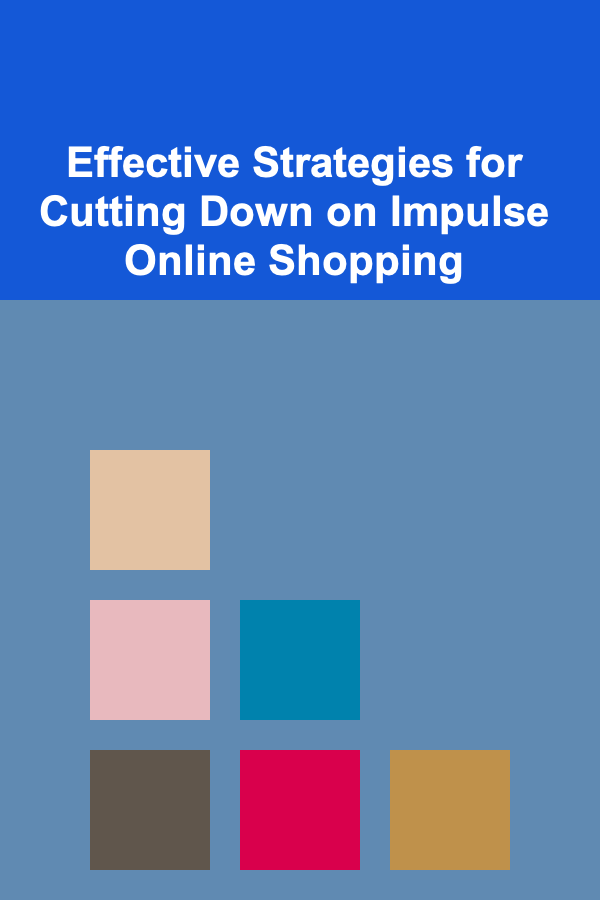
Effective Strategies for Cutting Down on Impulse Online Shopping
ebook include PDF & Audio bundle (Micro Guide)
$12.99$9.99
Limited Time Offer! Order within the next:

Online shopping is an easy and convenient way to buy products, but it can also lead to excessive spending, especially when impulse buys take over. With just a few clicks, we can easily purchase items that we don't need or didn't plan on buying. However, if left unchecked, impulse shopping can wreak havoc on our finances and lead to buyer's remorse. So, how can we take control and reduce these spur-of-the-moment purchases?
In this actionable guide, we'll explore practical strategies that can help curb the habit of impulse online shopping. Whether you want to save money, reduce clutter, or simply be more mindful of your purchases, these techniques will put you back in the driver's seat of your shopping habits.
Recognize Your Triggers
Before you can tackle impulse shopping, it's important to identify what triggers it. We don't always buy things impulsively for the same reasons. For some, it may be emotional, while for others, it could be a matter of convenience or boredom.
Common Triggers of Impulse Buying
- Stress or emotional highs: Some people shop when they're feeling anxious, sad, or even overly happy. Buying something new provides a temporary rush of pleasure.
- Sales and discounts: Flash sales, "limited-time offers," and "last-chance" promotions can pressure us to make quick decisions without thinking about the consequences.
- Easy access and convenience: The ease of browsing and buying with just one click can make it hard to resist.
- Social influence: Seeing others post about their purchases or discussing hot trends online can trigger a desire to own the same items.
By recognizing these patterns, you can take steps to break the cycle. Start paying attention to when you tend to shop impulsively and consider what's going on in your life at the time.
Set Clear Budget and Spending Goals
Having a clear budget is a powerful tool to control your impulse purchases. When you know exactly how much money you have to spend each month and what your priorities are, you'll be less likely to make spontaneous buys.
Practical Steps:
- Create a monthly budget: List all of your fixed expenses (e.g., rent, utilities) and variable expenses (e.g., groceries, entertainment). Allocate a specific amount for non-essential spending, and make sure to stick to it.
- Set a "cool-off" period: When you feel the urge to make an impulse buy, implement a rule where you wait 24-48 hours before making the purchase. This waiting period can help you evaluate if the item is truly necessary or just a passing desire.
- Track your spending: Use apps or spreadsheets to track your online purchases. Seeing your spending patterns can provide insight into how much you're really buying impulsively.
Establishing financial boundaries not only helps you resist the temptation to buy but also gives you a sense of control over your financial situation.
Unsubscribe from Promotional Emails
How often have you been tempted to purchase something simply because you received a notification of a sale or special promotion? Retailers use email marketing as one of the most effective tools to trigger impulse buys. Constant promotions in your inbox can make it difficult to resist making a purchase, even if you weren't planning on it.
Actionable Tips:
- Unsubscribe from mailing lists: Go through your inbox and unsubscribe from the mailing lists of retailers that tempt you to spend unnecessarily. It might seem like a small step, but it removes one avenue through which impulsive shopping can occur.
- Use email filters: If unsubscribing from certain lists feels overwhelming, set up filters to automatically direct promotional emails to a separate folder. This way, you won't see them unless you specifically go looking.
- Turn off notifications: Many retailers and apps send push notifications or SMS alerts about sales. Disable notifications from shopping apps and websites to eliminate the instant reminders that can push you toward impulsive purchases.
By reducing the influx of tempting offers, you'll lessen the chances of being influenced by time-sensitive deals and discounts.
Practice Mindful Shopping
Mindful shopping is the practice of making deliberate, thoughtful decisions about what you buy. Instead of impulsively adding items to your cart, take time to reflect on whether the purchase is truly necessary, whether it fits into your budget, and whether it will add value to your life.
Steps to Practice Mindful Shopping:
-
Ask yourself key questions: Before hitting the "Buy Now" button, ask yourself questions like:
- Do I really need this?
- Can I afford this within my budget?
- Will I still want it a week from now?
- Does it align with my long-term goals or values?
-
Avoid browsing when you're bored: Boredom can be a powerful impulse shopping trigger. If you're just mindlessly scrolling through websites, you're more likely to make purchases you don't need. Try to redirect your energy toward other activities, like reading, going for a walk, or doing something creative.
-
Make a shopping list: Create a specific shopping list for things you need and stick to it. When you go online shopping, only buy items on the list. If something is not on the list, avoid adding it to your cart.
Mindful shopping encourages conscious consumption, making you more selective and intentional with your purchases.
Use Technology to Your Advantage
Technology can be both the problem and the solution. Fortunately, there are several tools available to help you resist the urge to buy impulsively.
Tools to Combat Impulse Shopping:
- Use budgeting apps: Apps like Mint, YNAB (You Need a Budget), and PocketGuard help you keep track of your finances in real-time, preventing overspending and offering alerts when you're nearing your budget limit.
- Install shopping blockers: Some browser extensions can block or limit access to certain shopping websites, helping you avoid the temptation altogether. Extensions like StayFocusd, for example, can restrict the amount of time you spend on specific sites.
- Use virtual savings accounts: Consider using savings apps or features within your bank's app that allow you to set aside money for a "future purchase" or for specific goals. This gives you a visual reminder that you need to save for the things you want, which might help curb impulsive spending.
These technological tools can serve as a buffer between you and impulsive decisions, allowing you to make more calculated choices.
Reduce Online Shopping Accessibility
One of the most effective ways to cut down on impulse purchases is to make online shopping less convenient. By removing the friction points that make it so easy to buy, you're less likely to follow through with an impulse purchase.
Steps to Reduce Accessibility:
- Delete saved payment information: Many e-commerce sites offer the convenience of saving your payment information for one-click purchases. While this is convenient, it also makes it easier to buy things impulsively. Try deleting this information so that you have to manually enter your details, which can give you an extra moment to reconsider.
- Use a dedicated shopping account: If you frequently shop online, consider creating a separate account just for shopping. This will help you manage your purchases and avoid impulsive buying on your main accounts.
- Limit your shopping platforms: Remove shopping apps from your phone or set strict limits on how many times you check certain websites. By reducing how often you visit e-commerce platforms, you lessen the chances of seeing something that might trigger an impulse buy.
The more barriers you put between yourself and easy access to shopping, the less likely you are to engage in impulsive purchases.
Reward Yourself with Non-Material Benefits
Sometimes, impulse shopping is a way to seek instant gratification. Instead of reaching for your wallet to satisfy this need, consider non-material rewards that can bring you happiness without breaking the bank.
Ideas for Non-Material Rewards:
- Treat yourself to a spa day at home: Instead of buying new beauty products, pamper yourself with a relaxing bath, DIY facials, or home massages.
- Enjoy a hobby or leisure activity: Instead of spending money on things you don't need, indulge in a hobby like painting, writing, or exercising.
- Socialize without spending: Arrange a virtual or in-person hangout with friends that doesn't involve spending money. A walk in the park or a game night can be a great alternative to shopping for entertainment.
By finding fulfillment in ways that don't require purchasing new things, you'll be less likely to reach for your credit card when you're feeling the urge to splurge.
Conclusion
Cutting down on impulse online shopping is not about completely eliminating the joy of purchasing things you love. Instead, it's about finding balance and making intentional, mindful decisions that align with your financial goals and values. By recognizing your triggers, setting boundaries, using technology to your advantage, and adopting healthier shopping habits, you can regain control over your purchases and reduce unnecessary spending.
The key to success is consistency. With time, these strategies will become second nature, and you'll find yourself more confident and mindful in your shopping choices. Happy shopping (responsibly)!
Reading More From Our Other Websites
- [Home Lighting 101] How to Use Lighting Color Temperature to Set the Mood
- [Home Lighting 101] How to Use Lighting Controls to Enhance Your Home's Ambiance
- [Organization Tip 101] How to Organize Party Supplies in Your Pantry
- [Trail Running Tip 101] Seasonal Trail Running: How to Adapt Your Training for Spring, Summer, Fall, and Winter
- [Home Rental Property 101] How to Make Your Rental Property More Appealing to Renters
- [Personal Investment 101] How to Use ETFs for Diversified Investment Exposure
- [Personal Finance Management 101] How to Budget for a Family and Still Save for the Future
- [Organization Tip 101] How to Use Vertical Space for Better Organization
- [Home Lighting 101] How to Light Your Kitchen Like a Professional Chef
- [Organization Tip 101] How to Organize Your Wedding Music Playlist

10 Fun and Affordable Hobbies and Activities for Every Budget
Read More
How to Budget for Home Appliances and Technology Upgrades
Read More
How to Maximize Your Rental Property's Return on Investment (ROI)
Read More
How to Organize Tools and Equipment for Your Hobby
Read More
How to Whip Cream to Perfection
Read More
How to Optimize Your Audio Setup for Gaming
Read MoreOther Products

10 Fun and Affordable Hobbies and Activities for Every Budget
Read More
How to Budget for Home Appliances and Technology Upgrades
Read More
How to Maximize Your Rental Property's Return on Investment (ROI)
Read More
How to Organize Tools and Equipment for Your Hobby
Read More
How to Whip Cream to Perfection
Read More